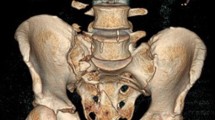Abstract
Posterior bridging plate osteosynthesis is an established stabilization technique for high-energy posterior pelvic ring disruptions. A reconstruction plate is placed posterior to the sacrum between the posterior superior iliac spines and bent around the posterior iliac crests. The plate can also be placed in the notch just inferior to the posterior inferior iliac spines. Long screws are inserted through the marginal plate holes on each side. An angular-stable plate may also be used in the same position. It is of major importance to place the plate below the fascia. A comparative biomechanical study demonstrated that the strength of the transiliac plate fixation was equal to that of transiliac sacral bar fixation with one or two bars. A transiliac locked compression plate can be used in mono- or bilateral sacral insufficiency fractures or impending insufficiency fractures with severe dorsal pain. In an 8-year period, we treated 55 patients with a fragility fracture of the sacrum with a posterior bridging locked compression plate. There were no neurovascular complications. There was one deep wound infection. All other patients could be mobilized with pain-adapted weight-bearing immediately after surgery. Posterior angular stable bridging plate osteosynthesis is a simple, safe, quick and reliable stabilization technique for patients with fragility fractures of the pelvis.
Similar content being viewed by others
References
Albert MJ, Miller ME, MacNaughton M, Hutton W. Posterior pelvic fixation using a transiliac 4.5-mm reconstruction plate: a clinical and biomechanical study. J Orthop Trauma. 1993;7:226–32.
Kellam J, McLaren A, Tile M. Internal fixation. In: Tile M, editor. Fractures of the pelvis and acetabulum. 2nd ed. Baltimore: William and Wilkins; 1995. p. 150–99. Chapter 10.
Dolati B, Larndorfer R, Krap**er D, Rosenberger RE. Stabilization of the posterior pelvic ring with a slide-insertion plate. Oper Orthop Traumatol. 2007;19:16–31.
Wagner M, Frigg R. AO manual of fracture management—internal fixators, Concepts and Cases using LCP and LISS. New York: Thieme; 2006.
Kobbe P, Hockertz I, Sellei RM, Reilmann H, Hockertz T. Minimally invasive stabilization of posterior pelvic-ring instabilities with a transiliac locked compression plate. Int Orthop (SICOT). 2012;36:159–64.
Krap**er D, Larndorfer R, Struve P, Rosenberger R, Arora R, Blauth M. Minimally invasive transiliac plate osteosynthesis for Type C injuries of the pelvic ring: a clinical and radiological follow-up. J Orthop Trauma. 2007;21:595–602.
Ayoub MA, Gad HM, Seleem OA. Standalone percutaneous transiliac plating of vertically unstable sacral fractures: outcomes, complications, and recommendations. Eur Spinde J. 2016;25(4):1153–62.
Author information
Authors and Affiliations
Corresponding author
Editor information
Editors and Affiliations
Rights and permissions
Copyright information
© 2017 Springer International Publishing AG
About this chapter
Cite this chapter
Hockertz, T. (2017). Bridging Plate Osteosynthesis. In: Rommens, P., Hofmann, A. (eds) Fragility Fractures of the Pelvis. Springer, Cham. https://doi.org/10.1007/978-3-319-66572-6_14
Download citation
DOI: https://doi.org/10.1007/978-3-319-66572-6_14
Published:
Publisher Name: Springer, Cham
Print ISBN: 978-3-319-66570-2
Online ISBN: 978-3-319-66572-6
eBook Packages: MedicineMedicine (R0)




